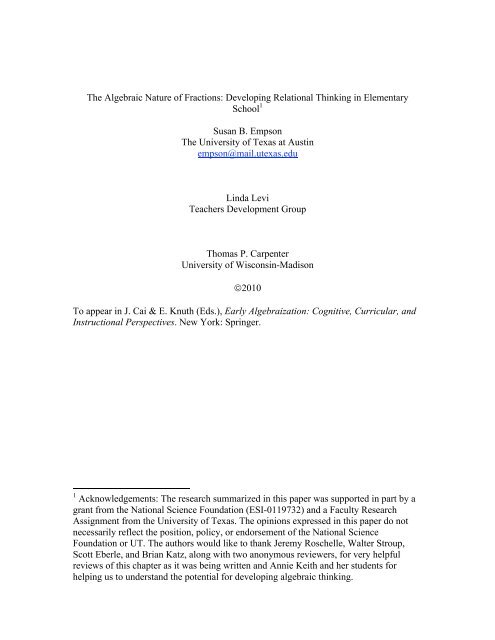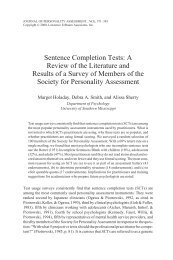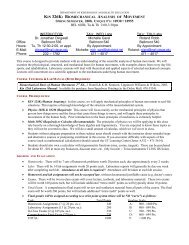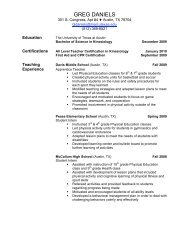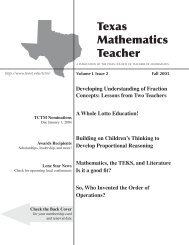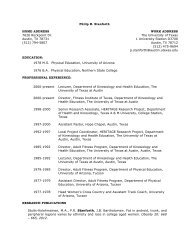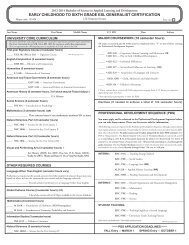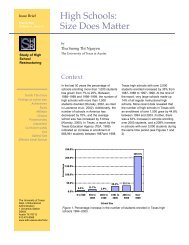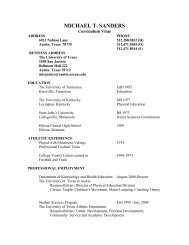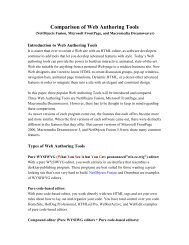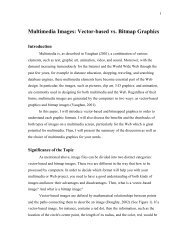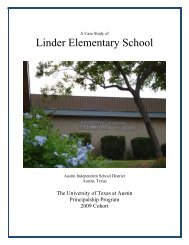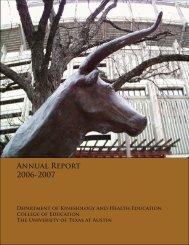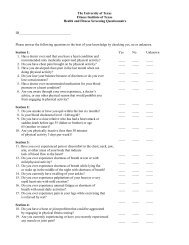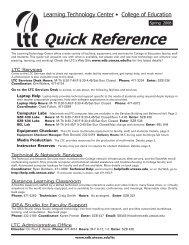The Algebraic Nature of Fractions: Developing Relational Thinking ...
The Algebraic Nature of Fractions: Developing Relational Thinking ...
The Algebraic Nature of Fractions: Developing Relational Thinking ...
You also want an ePaper? Increase the reach of your titles
YUMPU automatically turns print PDFs into web optimized ePapers that Google loves.
<strong>The</strong> <strong>Algebraic</strong> <strong>Nature</strong> <strong>of</strong> <strong>Fractions</strong>: <strong>Developing</strong> <strong>Relational</strong> <strong>Thinking</strong> in Elementary<br />
School 1<br />
Susan B. Empson<br />
<strong>The</strong> University <strong>of</strong> Texas at Austin<br />
empson@mail.utexas.edu<br />
Linda Levi<br />
Teachers Development Group<br />
Thomas P. Carpenter<br />
University <strong>of</strong> Wisconsin-Madison<br />
©2010<br />
To appear in J. Cai & E. Knuth (Eds.), Early Algebraization: Cognitive, Curricular, and<br />
Instructional Perspectives. New York: Springer.<br />
1 Acknowledgements: <strong>The</strong> research summarized in this paper was supported in part by a<br />
grant from the National Science Foundation (ESI-0119732) and a Faculty Research<br />
Assignment from the University <strong>of</strong> Texas. <strong>The</strong> opinions expressed in this paper do not<br />
necessarily reflect the position, policy, or endorsement <strong>of</strong> the National Science<br />
Foundation or UT. <strong>The</strong> authors would like to thank Jeremy Roschelle, Walter Stroup,<br />
Scott Eberle, and Brian Katz, along with two anonymous reviewers, for very helpful<br />
reviews <strong>of</strong> this chapter as it was being written and Annie Keith and her students for<br />
helping us to understand the potential for developing algebraic thinking.
<strong>Relational</strong> <strong>Thinking</strong> and <strong>Fractions</strong> 2<br />
<strong>The</strong> <strong>Algebraic</strong> <strong>Nature</strong> <strong>of</strong> <strong>Fractions</strong>: <strong>Developing</strong> <strong>Relational</strong> <strong>Thinking</strong> in Elementary<br />
School<br />
Susan B. Empson Linda Levi<br />
Thomas P. Carpenter<br />
Abstract: <strong>The</strong> authors present a new view <strong>of</strong> the relationship between learning<br />
fractions and learning algebra that 1) emphasizes the conceptual continuities between<br />
whole-number arithmetic and fractions; and 2) shows how the fundamental properties <strong>of</strong><br />
operations and equality that form the foundations <strong>of</strong> algebra are used naturally by<br />
children in their strategies for problems involving operating on and with fractions. This<br />
view is grounded in empirical research on how algebraic structure emerges in young<br />
children’s reasoning. Specifically, the authors argue that there is a broad class <strong>of</strong><br />
children’s strategies for fraction problems motivated by the same mathematical<br />
relationships that are essential to understanding high-school algebra and that these<br />
relationships cannot be presented to children as discrete skills or learned as isolated<br />
rules. <strong>The</strong> authors refer to the thinking that guides such strategies as <strong>Relational</strong><br />
<strong>Thinking</strong>.<br />
Key Words: fractions, relational thinking, algebra, elementary mathematics, problem<br />
solving<br />
345).<br />
“Of what use … is it to be able to see the end in the beginning?” (Dewey, 1974, p.<br />
<strong>Fractions</strong> and algebra are two topics in school mathematics that are considered<br />
critical to the curriculum and difficult to learn (National Council <strong>of</strong> Teachers <strong>of</strong><br />
Mathematics, 1998, 2000). Students’ misconceptions and procedural errors for fractions<br />
and algebra, for example, have been well documented (Kerslake, 1986; Matz, 1982;<br />
Sleeman, 1984; Stafylidou & Vosniadou, 2004). Moreover, high-school students’ poor<br />
performance in algebra has been blamed on their weak pr<strong>of</strong>iciency in fractions.<br />
According to a recent Math Panel report, for instance, the ability to perform fraction<br />
computations easily and quickly is one <strong>of</strong> the most critical foundations for algebra (U.S.<br />
Department <strong>of</strong> Education, 2008).
<strong>Relational</strong> <strong>Thinking</strong> and <strong>Fractions</strong> 3<br />
We see the relationship between fractions and algebra differently. If there is an<br />
obstacle to learning algebra, it begins to form as children learn basic arithmetic. As a<br />
direct result <strong>of</strong> typical approaches to instruction in the U.S., American students tend to<br />
understand arithmetic as a collection <strong>of</strong> procedures, rather than in terms <strong>of</strong> conceptual<br />
relationships or general properties <strong>of</strong> number and operation. By the time the problem is<br />
exposed as children learn fractions, it is fairly entrenched, and it is only exacerbated by<br />
the fact that fractions are taught in isolation from whole numbers and that fraction<br />
operations are taught as a collection <strong>of</strong> procedures. Concrete materials and models may<br />
help children make critical connections (Lesh, Post, & Behr, 1987), but our take on the<br />
types <strong>of</strong> connections that are most fruitful for understanding fractions represents a<br />
departure from earlier lines <strong>of</strong> thinking.<br />
In this chapter we present an alternative view on the relationship between<br />
fractions and algebra that 1) emphasizes the conceptual continuities between whole-<br />
number arithmetic and fractions; and 2) shows how the fundamental properties <strong>of</strong><br />
operations and equality that form the foundations <strong>of</strong> algebra are used naturally by<br />
children in their strategies for problems involving operating on and with fractions. We<br />
ground this view in research on children’s thinking to illustrate how algebraic structure<br />
emerges in young children’s reasoning and can, with the help <strong>of</strong> the teacher, be made<br />
explicit. Specifically, we argue that there is a broad class <strong>of</strong> children’s strategies for<br />
fraction problems motivated by the same mathematical relationships that are essential to<br />
understanding high-school algebra and that these relationships cannot be presented to<br />
children as discrete skills or learned as isolated rules. We refer to the thinking that guides<br />
such strategies as <strong>Relational</strong> <strong>Thinking</strong>.
<strong>Relational</strong> <strong>Thinking</strong> and <strong>Fractions</strong> 4<br />
<strong>The</strong>se arguments are based on our research over the last 14 years, in which we<br />
have been studying how to provide opportunities for students to engage in <strong>Relational</strong><br />
<strong>Thinking</strong> in elementary classrooms and how to use <strong>Relational</strong> <strong>Thinking</strong> to learn the<br />
arithmetic <strong>of</strong> whole numbers and fractions. We have focused on understanding children’s<br />
conceptions and misconceptions related to <strong>Relational</strong> <strong>Thinking</strong>, how conceptions<br />
develop, how teachers might foster the development and the use <strong>of</strong> <strong>Relational</strong> <strong>Thinking</strong><br />
to learn arithmetic, and how pr<strong>of</strong>essional development can support the teaching <strong>of</strong><br />
<strong>Relational</strong> <strong>Thinking</strong>. This research has included design experiments with classes and<br />
small groups <strong>of</strong> children (e.g. Falkner, Carpenter, & Levi 1999; Empson, 2003; Koehler<br />
2004; Valentine, Carpenter, & Pligge, 2004), case studies (Empson, Junk, Dominguez, &<br />
Turner, 2006; Empson & Turner 2006), and large-scale studies (Jacobs, Franke,<br />
Carpenter, Levi, & Battey, 2007); and it has been synthesized in two books (Carpenter,<br />
Franke, & Levi, 2003; Empson & Levi, forthcoming).<br />
In this chapter, we illustrate elementary school children’s use <strong>of</strong> relations and<br />
properties <strong>of</strong> operations as a basis for learning fractions and argue that <strong>Relational</strong><br />
<strong>Thinking</strong> is a critical foundation for learning algebra that should not be ignored. We first<br />
define <strong>Relational</strong> <strong>Thinking</strong> and then we discuss how the use <strong>of</strong> <strong>Relational</strong> <strong>Thinking</strong><br />
supports the development <strong>of</strong> children’s understanding <strong>of</strong> arithmetic. At the same time we<br />
challenge the notion that an invigorated focus on fractions in the middle grades is the key<br />
to equipping students to learn algebra meaningfully (Hiebert & Behr, 1988; U.S<br />
Department <strong>of</strong> Education, 2008). Instead, we argue that the key can be found in helping<br />
children to see the continuities among whole numbers, fractions, and algebra. Finally, we<br />
suggest that a model <strong>of</strong> the development <strong>of</strong> children’s understanding <strong>of</strong> arithmetic that is
<strong>Relational</strong> <strong>Thinking</strong> and <strong>Fractions</strong> 5<br />
based upon a concrete to abstract mapping is too simplistic. We propose instead that<br />
developing computational procedures based on <strong>Relational</strong> <strong>Thinking</strong> could effectively<br />
integrate children’s learning <strong>of</strong> the whole-number and fraction arithmetic in elementary<br />
mathematics, in anticipation <strong>of</strong> the formalization <strong>of</strong> this thinking in algebra.<br />
What is <strong>Relational</strong> <strong>Thinking</strong>?<br />
<strong>Relational</strong> <strong>Thinking</strong> involves children’s use <strong>of</strong> fundamental properties <strong>of</strong><br />
operations and equality 2 to analyze a problem in the context <strong>of</strong> a goal structure and then<br />
to simplify progress towards this goal (Carpenter, et al., 2003; see also Carpenter, Franke,<br />
Levi, & Zeringue, 2005; Jacobs, et al., 2007). <strong>The</strong> use <strong>of</strong> fundamental properties to<br />
generate a goal structure and to transform expressions can be explicit or it can be implicit<br />
in the logic <strong>of</strong> children’s reasoning much like Vergnaud’s (1988) theorems in action.<br />
reason that 1<br />
2<br />
For example, to calculate 1 3<br />
2 + 4<br />
plus another 1<br />
2<br />
a child may think <strong>of</strong> 3<br />
4<br />
is equal to 1, then plus another<br />
1<br />
4<br />
1 1<br />
as equal to 2 + 4 and<br />
is 1<br />
1 . In a study by<br />
4<br />
Empson (1999), several first graders reasoned this way when given a story problem<br />
involving these fractional quantities. This solution involves anticipatory thinking, a<br />
construct introduced by Piaget and colleagues (Piaget, Inhelder, & Szeminksa, 1960) to<br />
characterize the use <strong>of</strong> psychological structures to coordinate a goal with the subgoals<br />
used to accomplish it; thinking can involve several such coordinations. <strong>The</strong>se students<br />
recognized that they could decompose 3<br />
4<br />
1 1 into 2 + 4 , and that if they decomposed it this<br />
way, they could regroup to add 1 1<br />
3<br />
2 + 2 . In other words, they transformed 4<br />
1 1 to 2 + 4 in<br />
2 Essentially, we are referring here to the Field properties and basic properties <strong>of</strong> equality<br />
(Herstein, 1996; see also Carpenter et al., 2003; Empson & Levi, forthcoming;).
<strong>Relational</strong> <strong>Thinking</strong> and <strong>Fractions</strong> 6<br />
anticipation <strong>of</strong> adding 1 1<br />
2 + 2 . This solution involved thinking flexibly about both the<br />
quantity 3<br />
4<br />
and about the operation, taken into account concurrently rather than<br />
separately as a series <strong>of</strong> isolated steps. <strong>The</strong>ir thinking can be represented by the following<br />
equalities:<br />
1 3 1<br />
+ = + (1<br />
2 4 2 2<br />
1<br />
+ ) = (1<br />
4 2<br />
1 1 1 1<br />
+ ) + = 1 + = 1<br />
2 4 4 4<br />
Although the first graders did not represent their reasoning symbolically in this way, their<br />
solution is justified in part by the implicit use <strong>of</strong> the associative property <strong>of</strong> addition,<br />
which we have represented explicitly here to highlight the logic <strong>of</strong> the their thinking.<br />
<strong>Relational</strong> <strong>Thinking</strong> is powerful because the applicability <strong>of</strong> fundamental<br />
properties such as the associative property <strong>of</strong> addition and the distributive property <strong>of</strong><br />
multiplication over addition cut across number domains and into the domain <strong>of</strong> algebra<br />
where one reasons about general quantities rather than specific numbers. Consider the<br />
expression 7a + 4a. A basic algebraic skill is to simplify this expression to 11a, by<br />
application <strong>of</strong> the distributive property <strong>of</strong> multiplication over addition:<br />
7a + 4a = (7 + 4)a = 11a<br />
<strong>The</strong> same property that justifies this transformation can also be used to justify that 70 +<br />
40 = 110 and<br />
7<br />
5 +<br />
4<br />
5 =<br />
11<br />
5 :<br />
70 + 40 = 7 × 10 + 4 × 10 = (7 + 4) × 10 = 11× 10 = 110<br />
7 4 1 1 1 1 11<br />
+ = 7 × + 4 × = (7 + 4) × = 11× =<br />
5 5 5 5 5 5 5<br />
Yet addition <strong>of</strong> whole numbers and addition <strong>of</strong> fractions are taught in isolation from each<br />
other in the elementary curriculum, and they are <strong>of</strong>ten taught by rote, without reference<br />
either to the underlying properties or the process <strong>of</strong> deciding how and when to use a
<strong>Relational</strong> <strong>Thinking</strong> and <strong>Fractions</strong> 7<br />
property. For example, to add fractions children are taught to first find a common<br />
denominator and then add the two numerators; many children remember this process as a<br />
series <strong>of</strong> steps to execute. <strong>The</strong>y are not encouraged to draw on their understanding <strong>of</strong> the<br />
distributive property either to derive or to explain this procedure. Many children are<br />
therefore simply not prepared later to explicitly draw on the appropriate properties to<br />
justify why 7a + 4a is 11a, but 7a + 4b is not 11ab.<br />
Children learn arithmetic with understanding when they are encouraged to use<br />
and develop their intuitive understanding <strong>of</strong> the properties <strong>of</strong> number and operation. Our<br />
research has led us to recast the meaning <strong>of</strong> learning with understanding in terms <strong>of</strong><br />
thinking relationally: to understand arithmetic is to think relationally about arithmetic,<br />
because the coherence <strong>of</strong> operations on whole numbers and fractions is found at the level<br />
<strong>of</strong> the fundamental properties <strong>of</strong> operations and equality. Teaching arithmetic in general<br />
and fractions in particular primarily as a set <strong>of</strong> procedures fails to introduce children to<br />
the powerful reasoning structures that form the basis <strong>of</strong> our number system. On the other<br />
hand, if children enter algebra with a well developed ability to think relationally about<br />
operations, they are prepared to learn to reason meaningfully about and carry out<br />
transformations involving generalized expressions through the explicit application <strong>of</strong><br />
algebraic properties. In the following section we show how these properties emerge and<br />
can be developed in the context <strong>of</strong> carrying out number operations involving fractions<br />
and we discuss their connections to learning algebra.<br />
Use <strong>of</strong> <strong>Relational</strong> <strong>Thinking</strong> in Learning <strong>Fractions</strong>
<strong>Relational</strong> <strong>Thinking</strong> and <strong>Fractions</strong> 8<br />
Children’s difficulties learning fractions have been well documented (Kerslake,<br />
1986; Stafylidou & Vosniadou, 2004). <strong>The</strong> difficulty, however, may be in how fractions<br />
are taught rather than how intrinsically easy or hard they are to understand. Indeed, a<br />
conclusion we draw from our research is that fractions are not unduly difficult if<br />
instruction develops children’s capacity for <strong>Relational</strong> <strong>Thinking</strong>.<br />
A focus on <strong>Relational</strong> <strong>Thinking</strong> can transform fractions into a topic that children<br />
understand by drawing on and reinforcing the fundamental properties that govern<br />
reasoning about both whole-number and fraction quantities and operations. Children use<br />
<strong>Relational</strong> <strong>Thinking</strong> in their solutions to story problems (e.g., Baek, 2008; Carpenter,<br />
Franke, Jacobs, Fennema, & Empson, 1998; Empson, et al., 2006) and open number<br />
sentences (Carpenter, et al., 2005). Teachers can cultivate children’s use <strong>of</strong> <strong>Relational</strong><br />
<strong>Thinking</strong> by using a combination <strong>of</strong> these types <strong>of</strong> problems. In this chapter we focus on<br />
children’s <strong>Relational</strong> <strong>Thinking</strong> in the context <strong>of</strong> solving story problems.<br />
Understanding Fractional Quantities Through <strong>Relational</strong> <strong>Thinking</strong><br />
Before children can learn to operate on or with fractions, they need to understand<br />
fractions as quantities. Because a fraction is defined by the multiplicative relationship<br />
between two integers, a mature understanding <strong>of</strong> fractions as quantities is relational in<br />
nature. Young children can construct a rudimentary relational understanding <strong>of</strong> fractions<br />
by solving and discussing Equal Sharing problems (Empson, 1999; Empson & Levi,<br />
forthcoming; Streefland, 1993).<br />
To solve a problem about equally sharing quantities, such as two pancakes shared<br />
among three children, children must partition the quantities equally and completely.<br />
Children’s earliest, non-relational strategies <strong>of</strong>ten involve partitioning the pancakes into
<strong>Relational</strong> <strong>Thinking</strong> and <strong>Fractions</strong> 9<br />
halves. In this example the two pancakes would yield four halves. A child using this<br />
strategy might then try to distribute the four halves into three groups. When the child<br />
discovers that there is a half left over, the child may then partition the extra half into half,<br />
and then partition each <strong>of</strong> those parts into half again, continuing until the parts get too<br />
small to partition. This solution is not relational in that it lacks anticipatory thinking. <strong>The</strong><br />
child knows that it is necessary to partition the pieces to share them, but approaches the<br />
problem one step at a time, partitioning into halves without anticipating how the resulting<br />
parts are going to be shared.<br />
Children begin to think relationally about fractional quantities when they begin to<br />
reason about the relationship between partitions into equal and exhaustive shares and the<br />
number <strong>of</strong> sharers. To solve two pancakes shared by three children, a child could decide<br />
to completely share the first pancake with all three children, and then to share the second<br />
pancake in the same way (Fig. 1). Alternatively, a child who began by distributing one<br />
half to each person might then decide to partition the left over half into three equal parts.<br />
In either case, a child who thinks about the number <strong>of</strong> people sharing and at the same<br />
time how to partition the things to be shared is in the process <strong>of</strong> developing a relational<br />
understanding <strong>of</strong> fractions.<br />
-- Insert Fig. 1 about here --<br />
This strategy for creating two thirds implicitly uses several important<br />
mathematical relationships. For ease <strong>of</strong> illustration, we concentrate on the strategy in
<strong>Relational</strong> <strong>Thinking</strong> and <strong>Fractions</strong> 10<br />
which the child partitions each whole candy bar into thirds. Although young children are<br />
unlikely to use the following notation to represent their reasoning, it follows this logic:<br />
2 ÷ 3 = (1+ 1) ÷ 3 = 1 ÷ 3 + 1 ÷ 3 = 1 1 2<br />
+ =<br />
3 3 3<br />
This reasoning embodies the knowledge that three one-thirds make a whole pancake and<br />
that one pancake divided among three people yields one-third <strong>of</strong> a pancake to each. It<br />
also suggests an intuitive understanding <strong>of</strong> how a “distributive-like property” can be<br />
applied to division. 3<br />
A fully operationalized and explicit understanding <strong>of</strong> fractions as relational<br />
quantities develops gradually. Most basic to this understanding is that unit fractions are<br />
created by division or partitioning and that unit fractions are multiplicatively related to<br />
the whole:<br />
(1) 1 ÷ n = 1<br />
n<br />
1<br />
and × n = 1<br />
n<br />
Multiple opportunities to combine unit-fraction quantities in solutions to Equal Sharing<br />
problems and to notate these solutions—such as “1 third and 1 third equals 2 thirds”—<br />
lead to the following more generalized relational understanding:<br />
(2) m × 1 m<br />
=<br />
n n<br />
<strong>The</strong> conceptual connections between children’s pictorial and symbolic representations <strong>of</strong><br />
fractional quantities require prolonged attention to develop in a flexible, integrated way<br />
(Empson, et al., 2006; Saxe, et al., 1999). <strong>The</strong>se relationships are initially grounded in<br />
3<br />
This property can be represented as a ÷ c + b ÷ c = (a + b) ÷ c , which is equivalent to<br />
a × 1 1<br />
1<br />
c + b × c = (a + b) × c . It is sometimes referred to as the right distributive property <strong>of</strong><br />
division over addition. On the other hand, a ÷ (b + c) is not the same as a ÷ c + a ÷ c ; that<br />
is, there is no left distributive property <strong>of</strong> division over addition.
<strong>Relational</strong> <strong>Thinking</strong> and <strong>Fractions</strong> 11<br />
children’s informal knowledge <strong>of</strong> partitioning quantities, such as cupcakes and<br />
sandwiches. Children arrive at the generalized relational understanding represented by<br />
equations (1) and (2) above as the result <strong>of</strong> repeated opportunities to create, represent,<br />
and reason about these relationships in various interlinked forms over an extended period<br />
<strong>of</strong> time.<br />
Understanding these basic relationships is absolutely critical to children’s ability<br />
to reason with understanding about fraction operations and computations. Consider the<br />
case <strong>of</strong> Holly, a fifth grader who had been exposed to fraction instruction throughout her<br />
school career but did not understand fractions as relational quantities. She had learned<br />
that fractions involved partitioning wholes into parts, but she did not understand the<br />
relation between the parts and the whole. Fractional parts, to her, were entities unrelated<br />
to whole numbers. <strong>The</strong>se limitations in her understanding were exposed in her solution to<br />
the following problem:<br />
“Jeremy is making cupcakes. He wants to put<br />
1<br />
2<br />
a cup <strong>of</strong> frosting on each<br />
cupcake. If he makes 4 cupcakes for his birthday party, how much frosting<br />
will he use to frost all <strong>of</strong> the cupcakes?”<br />
To solve the problem, Holly drew the picture in Figure 2 and decided the answer was<br />
“four halves.” Upon further questioning, it became clear that Holly did not see how these<br />
quantities could be combined; she insisted the answer was four halves and four halves<br />
only. It seemed instead that the entire circle partitioned in half represented the fraction<br />
for Holly, and it would have been nonsensical to combine them (akin to asking, “How<br />
much is 4 apples?”). For her, fractions existed separately from other numerical measures.<br />
1<br />
2
-- Insert Fig. 2 about here –<br />
<strong>Relational</strong> <strong>Thinking</strong> and <strong>Fractions</strong> 12<br />
Contrast Holly’s solution to a third grader’s solution to the following problem.<br />
“Mr. W has 10 cups <strong>of</strong> frog food. His frogs eat<br />
How long can he feed his frogs before his food runs out?”<br />
1 a cup <strong>of</strong> frog food a day.<br />
2<br />
<strong>The</strong> third grader, John, represented each cup <strong>of</strong> frog food with a rectangle, then divided<br />
each rectangle in half and notated “<br />
1 ” on each half to show how much food Mr. W’s<br />
2<br />
frogs could eat in a day (Fig. 3). He then counted these to arrive at an answer <strong>of</strong> 20 days.<br />
Unlike Holly, John used a relational understanding <strong>of</strong> the quantity 2 × 1<br />
2 = 1 to construct a<br />
solution. John’s solution represents a big step forward over Holly’s. He might have gone<br />
further in his use <strong>of</strong> <strong>Relational</strong> <strong>Thinking</strong> by grouping the half cups in order to figure the<br />
total number <strong>of</strong> days more efficiently. For example, he could have reasoned that 2 half<br />
cups are one cup, 4 half cups are 2 cups and so on, until he reached the number <strong>of</strong> half<br />
cups in 10 whole cups. He also could have reasoned directly that 20 groups <strong>of</strong><br />
1<br />
2<br />
are the<br />
same as 10 groups <strong>of</strong> 1. This type <strong>of</strong> reasoning, which takes into account both a relational<br />
understanding <strong>of</strong> fractional quantities and relations involving the operation <strong>of</strong><br />
multiplication, is illustrated in the cases in the following section.<br />
--Insert Fig. 3 about here--<br />
Use <strong>of</strong> <strong>Relational</strong> <strong>Thinking</strong> to Make Sense <strong>of</strong> Operations Involving <strong>Fractions</strong><br />
As children come to understand fractions as relational quantities, they start to use<br />
this understanding to decompose and recompose quantities for the purpose <strong>of</strong>
<strong>Relational</strong> <strong>Thinking</strong> and <strong>Fractions</strong> 13<br />
transforming expressions and simplifying computations. <strong>The</strong>se manipulations are done<br />
purposefully and draw on a) children’s intuitive understanding <strong>of</strong> fractions as relational<br />
quantities described above and b) children’s relational understanding <strong>of</strong> operations<br />
cultivated in the context <strong>of</strong> whole-number reasoning and problem solving.<br />
Children’s strategies for multiplication and division word problems involving<br />
fractions can draw on and reinforce their growing understanding <strong>of</strong> the multiplicative<br />
nature <strong>of</strong> fractions. At the same time, the use <strong>of</strong> such problems supports the emergence <strong>of</strong><br />
<strong>Relational</strong> <strong>Thinking</strong> about operations as children attempt to figure out how to make<br />
operations more efficient. Children’s thinking becomes more anticipatory in that they<br />
begin to make choices about how to decompose and recompose fractions in the context <strong>of</strong><br />
a goal structure that relates operations and quantities. This anticipatory thinking signals<br />
the purposeful use <strong>of</strong> fundamental properties <strong>of</strong> operations and equality and is in contrast<br />
with algorithmic thinking about operations in which the goal structure can be summarized<br />
as “do next.”<br />
A pivotal point in the growth <strong>of</strong> children’s understanding is reached when<br />
children begin to use <strong>Relational</strong> <strong>Thinking</strong> to make repeated addition or subtraction <strong>of</strong><br />
fractions more efficient by applying fundamental properties <strong>of</strong> operations and equality in<br />
their strategies for combining quantities. <strong>The</strong> emergence <strong>of</strong> <strong>Relational</strong> <strong>Thinking</strong> about<br />
operations in this context is facilitated by the need to combine several groups <strong>of</strong> equal<br />
size. For example, in one <strong>of</strong> the cases that follows, a fifth-grade student wanted to figure<br />
eight groups <strong>of</strong> three eighths each. <strong>The</strong> child reasoned that eight groups <strong>of</strong> one eighth<br />
each equals one, so three such groups would be three. This reasoning makes implicit use<br />
<strong>of</strong> the commutative and associative properties <strong>of</strong> multiplication (Table 1).
--- Insert table 1 about here ---<br />
<strong>Relational</strong> <strong>Thinking</strong> and <strong>Fractions</strong> 14<br />
As children’s understanding <strong>of</strong> fractions grows, basic relationships as illustrated<br />
in Table 1 serve as building blocks in more sophisticated <strong>Relational</strong> <strong>Thinking</strong> strategies.<br />
<strong>The</strong>se strategies draw upon a variety <strong>of</strong> these properties in ways that are anticipatory<br />
rather algorithmic and in ways that demonstrate a well connected understanding <strong>of</strong><br />
number and operation. Most notably, these strategies are driven by each child’s<br />
understanding and therefore cannot and should not be reduced to a generalized series <strong>of</strong><br />
steps for all children to follow. In fact, a teacher would be hard pressed to explicitly teach<br />
these strategies, because each step is embedded in a goal structure that is specific to each<br />
child’s relational understanding <strong>of</strong> the operations and quantities for a given problem. In<br />
the long run, this relational understanding <strong>of</strong> number and operations results in an<br />
efficiency in learning advanced mathematics, such as algebra.<br />
To illustrate the types <strong>of</strong> <strong>Relational</strong> <strong>Thinking</strong> that elementary students are capable<br />
<strong>of</strong> using, we discuss two strategies generated by fifth and sixth graders in different<br />
classrooms. <strong>The</strong> teachers in these classrooms tended to place responsibility for generating<br />
and using conceptually sound strategies on each individual student. 4 This approach to<br />
instruction does not typify instruction in U.S. classrooms, and so the strategies we<br />
describe here are not representative <strong>of</strong> the current performance <strong>of</strong> U.S. children in the<br />
upper elementary grades (e.g., Hiebert, Gallimore, Garnier, et al., 2003). However, they<br />
are representative <strong>of</strong> the types strategies that evolve in classrooms such as these – even if<br />
4 We have observed patterns both in the types <strong>of</strong> <strong>Relational</strong> <strong>Thinking</strong> used and how it<br />
develops, which are beyond the scope <strong>of</strong> this chapter (see Empson & Levi, forthcoming).
<strong>Relational</strong> <strong>Thinking</strong> and <strong>Fractions</strong> 15<br />
these classrooms are rare – and provide a study <strong>of</strong> the possibility <strong>of</strong> integrating fractions<br />
and algebra in the upper elementary grades.<br />
Each problem involved division with a remainder to be taken into account in the<br />
quotient. For each case, we describe the strategy and then note how children used<br />
fundamental properties <strong>of</strong> operations and equality in their solutions.<br />
Case 1: Measurement division.<br />
<strong>The</strong> first case comes from a combination fourth- and fifth-grade class, working on<br />
the following measurement division problem:<br />
“It takes ____ <strong>of</strong> a cup <strong>of</strong> sugar to make a batch <strong>of</strong> cookies. I have 5<br />
sugar. How many batches <strong>of</strong> cookies can I make?”<br />
<strong>The</strong> students were given a variety <strong>of</strong> number choices for the divisor. In order <strong>of</strong><br />
difficulty, these choices were<br />
work with<br />
3<br />
8 <strong>of</strong> a cup <strong>of</strong> sugar.<br />
1<br />
2 ,<br />
1<br />
4 ,<br />
3<br />
4 , and<br />
1<br />
2<br />
cups <strong>of</strong><br />
3<br />
8 . Several students, including Jill, chose to<br />
Jill began her strategy by drawing upon the basic multiplicative relationship<br />
described above to generate familiar groupings <strong>of</strong> three eighths that would simplify the<br />
calculation (Table 1). She said she knew that 8 three-eighths would be 3, which meant<br />
that 4 three-eighths would be half that much, or 1<br />
be 4<br />
1 , and 12 three-eighths would therefore<br />
2<br />
1<br />
1<br />
(Fig. 4). At this point, she knew that she needed only 1 more cup to use up all 5<br />
2 2<br />
cups. Again Jill used the relationship between<br />
3<br />
8<br />
and 3 as a reference point. She said that<br />
because 8 three-eighths was 3, a third as many three-eighths would be a third as much, or<br />
1. That is, ( 1<br />
3<br />
3 × 8) × 8<br />
12 + 8<br />
3<br />
1 is 1, and 3 × 8 is<br />
batches, which would be equal to 14<br />
8<br />
3 . She concluded that she could make a total <strong>of</strong><br />
2<br />
3 batches.
--- Insert Fig. 4 about here ---<br />
<strong>Relational</strong> <strong>Thinking</strong> and <strong>Fractions</strong> 16<br />
If we unpack Jill’s description <strong>of</strong> her solution, we see that it involved setting<br />
subgoals that were readily solved using familiar relations. <strong>The</strong> solution <strong>of</strong> one subgoal<br />
provided a springboard for the next. Fundamental properties <strong>of</strong> operations and equality<br />
were implicit in the solution <strong>of</strong> each <strong>of</strong> the subgoals. Jill’s ultimate goal was to find how<br />
many<br />
3<br />
1<br />
8 cups it would take to make 5 2<br />
cups. She started with an overarching view <strong>of</strong> the<br />
problem that facilitated the formulation <strong>of</strong> a series <strong>of</strong> subgoals. <strong>The</strong> 5<br />
partitioned into parts that would be easily divided by<br />
combined.<br />
Jill’s first subgoal was to identify a multiple <strong>of</strong><br />
1<br />
2<br />
cups could be<br />
3<br />
8 . <strong>The</strong>n the parts could be<br />
3<br />
8 that would give her a whole<br />
number that she might subsequently use as a building block to find how many<br />
took to make 5<br />
3<br />
8<br />
cups it<br />
1 cups. Drawing implicitly on the kind <strong>of</strong> thinking described in Table 1,<br />
2<br />
she started with the equation 8 groups <strong>of</strong><br />
3<br />
8<br />
is 3.<br />
Because she had only accounted for 3 <strong>of</strong> the 5<br />
now had to find how many<br />
use the equation involving 8 groups <strong>of</strong><br />
3<br />
8<br />
cups it took to make 2<br />
3<br />
8<br />
1<br />
2<br />
to make another 1<br />
1 cups <strong>of</strong> flour in the problem, Jill<br />
2<br />
cups. She recognized that she could<br />
1<br />
2<br />
cups and that would leave<br />
exactly one cup to deal with. Essentially she used the multiplicative property <strong>of</strong> equality<br />
and the associative property <strong>of</strong> multiplication to transform the equation 8 × 3<br />
8 = 3 as<br />
follows:
1<br />
2<br />
3 1<br />
× (8 × ) = × 3<br />
8 2<br />
( 1 3<br />
× 8) × = 11<br />
2 8 2<br />
4 × 3<br />
= 11<br />
8 2<br />
<strong>The</strong> next subgoal was to find how many<br />
3<br />
8<br />
<strong>Relational</strong> <strong>Thinking</strong> and <strong>Fractions</strong> 17<br />
cups it took to make the remaining one<br />
cup. Jill also used the equation 8 × 3<br />
8 = 3 as the basis for addressing this subgoal. She<br />
again used the multiplicative property <strong>of</strong> equality and the associative property <strong>of</strong><br />
multiplication to transform the core equation as shown below.<br />
8 × 3<br />
= 3<br />
8<br />
1 3 1<br />
× (8 × ) = × 3<br />
3 8 3<br />
( 1 3<br />
× 8) ×<br />
3 8 =1<br />
8 3<br />
×<br />
3 8 =1<br />
Note Jill might have simply used the reciprocal relation between<br />
8<br />
3 and<br />
3<br />
8<br />
for this<br />
calculation, but she continued to build <strong>of</strong>f <strong>of</strong> the equation 8 × 3<br />
8 = 3 . Although we believe<br />
it is likely that she did not intend to generate the reciprocal relationship between<br />
8<br />
3 and<br />
we find its emergence here significant, because it illustrates how algebraic relationships<br />
can emerge fairly naturally in the context <strong>of</strong> children’s relational reasoning. Problems<br />
such as this one provide experience with this relation.<br />
Finally, Jill put the parts together using the additive property <strong>of</strong> equality and the<br />
distributive property.<br />
8 × 3 3 8 3<br />
1<br />
+ 4 × + × = 3 + 11 + 1 = 5<br />
8 8 3 8 2 2<br />
3<br />
8 ,
and<br />
8 × 3 3 8 3<br />
+ 4 × + ×<br />
8 8 3 8<br />
<strong>Relational</strong> <strong>Thinking</strong> and <strong>Fractions</strong> 18<br />
8 3<br />
= (8 + 4 + ) ×<br />
3 8<br />
= 14 2 3<br />
×<br />
3 8<br />
<strong>The</strong> kinds <strong>of</strong> thinking implicit in Jill’s strategy are directly related to the kinds <strong>of</strong><br />
thinking that are involved in solving algebra problems with meaning. She started with a<br />
primary goal – to find how many 3<br />
1<br />
8 -cups were in 5 2<br />
cups – which subsequently guided<br />
the formulation <strong>of</strong> her subgoals. To make progress on solving the problem, she<br />
transformed the primary goal into a series <strong>of</strong> subgoals for which she had a ready solution.<br />
This practice is fundamental to high-school algebra in which a series <strong>of</strong> properties <strong>of</strong><br />
operations and equality are <strong>of</strong>ten used to simplify a complex equation. For example, to<br />
solve a linear equation in one unknown, students set subgoals that entail finding<br />
successively simpler equations that are closer to the goal <strong>of</strong> finding an equation <strong>of</strong> the<br />
form x = a number. As in the above example, the subgoals are met by repeated<br />
application <strong>of</strong> fundamental properties <strong>of</strong> operations and equality. Similarly, the goal <strong>of</strong><br />
solving a quadratic equation is transformed into subgoals <strong>of</strong> solving simple linear<br />
equations by applying a corollary <strong>of</strong> the zero property <strong>of</strong> multiplication ( a × b = 0 , if and<br />
only if a = 0 or b = 0).<br />
To address each <strong>of</strong> the subgoals, Jill essentially constructed and transformed<br />
relationships <strong>of</strong> equality using fundamental properties <strong>of</strong> operations and equality in ways<br />
that were strikingly similar to the thinking used in constructing and solving equations in<br />
formal treatments <strong>of</strong> algebra. She drew on anticipatory thinking in transforming the<br />
equations into equations that could be put together to solve the problem. In other words
<strong>Relational</strong> <strong>Thinking</strong> and <strong>Fractions</strong> 19<br />
she consistently constructed and transformed equations in ways that brought her closer to<br />
the solution <strong>of</strong> the basic problem. Again, that is essentially what solving algebra<br />
equations is all about.<br />
Case 2: Partitive division<br />
problem:<br />
Our second case involves a sixth-grade boy, Keenan, who solved the following<br />
“Two thirds <strong>of</strong> a bag <strong>of</strong> c<strong>of</strong>fee weighs 2.7 pounds. How much would a whole<br />
bag <strong>of</strong> c<strong>of</strong>fee weigh?”<br />
This problem involves partitive division and differs from the previous division<br />
problem in that the goal is to find out how much per group rather than to find out how<br />
many groups. Keenan’s strategy included the transformation <strong>of</strong> quantities for the purpose<br />
<strong>of</strong> simplifying calculations as well as the flexible use <strong>of</strong> several fundamental properties <strong>of</strong><br />
operations and equality (Fig. 5).<br />
--- Insert Fig. 5 about here ---<br />
To start, Keenan recognized that the problem was a division problem and wrote<br />
2.7 ÷ 2<br />
3 . He remarked, “Two divided by<br />
worry about is the seven tenths. Seven tenths divided by<br />
2<br />
3<br />
is going to be really easy, all I really need to<br />
2<br />
3<br />
isn’t easy to think about so<br />
[long pause] if I make them both thirtieths, it would be easier.” He notated his thinking so<br />
that it read:<br />
21 20<br />
÷<br />
30 30
<strong>Relational</strong> <strong>Thinking</strong> and <strong>Fractions</strong> 20<br />
and then said, “21 thirtieths divided by 20 thirtieths is just the same as 21 divided by 20<br />
which is one and one twentieth.” He notated his answer:<br />
21 20 1<br />
÷ = 1<br />
30 30 20<br />
Keenan then said, “Now all I have to do is 2 divided by<br />
he knew that so quickly he said, “2 divided by<br />
1<br />
3<br />
in each 1, so 2 divided by<br />
extended his notation as follows:<br />
2<br />
3<br />
would be 3 since<br />
1<br />
3<br />
2 , which is 3.” When asked how<br />
3<br />
would be 6 since you have 3 groups <strong>of</strong><br />
2<br />
3<br />
is twice as big as<br />
2.7 ÷ 2 1 2 1 1<br />
= 1 + 2 ÷ = 1 + 3 = 4<br />
3 20 3 20 20<br />
1 .” He then<br />
3<br />
This strategy incorporates several instances <strong>of</strong> <strong>Relational</strong> <strong>Thinking</strong>. Keenan began<br />
by decomposing 2.7 into .7 + 2 . This choice involved anticipatory thinking in that he<br />
analyzed the problem to see what relationships he might draw upon to simplify his<br />
calculations, rather than simply begin to execute a series <strong>of</strong> steps to solve the problem.<br />
He used the commutative property <strong>of</strong> addition and a “distributive-like” property to<br />
simplify the division. Although he did not notate this step, his thinking could be<br />
represented as:<br />
2.7 ÷ 2<br />
2<br />
2 2 2<br />
= (2 + .7) ÷ = (.7 + 2) ÷ = .7 ÷ + 2 ÷<br />
3 3 3 3 3<br />
Of note is his correct use <strong>of</strong> this distributive-like property for division. This division<br />
relationship is generalizable and can be justified with the distributive property <strong>of</strong><br />
multiplication over addition in conjunction with the inverse relationship between<br />
multiplication and division (see footnote 3).
2<br />
3 into<br />
Next Keenan facilitated the computation <strong>of</strong><br />
20<br />
30<br />
<strong>Relational</strong> <strong>Thinking</strong> and <strong>Fractions</strong> 21<br />
.7 ÷ 2<br />
3<br />
and then using these transformed quantities as follows:<br />
.7 ÷ 2 21 20<br />
1<br />
= ÷ = 21 ÷ 20 =1<br />
3 30 30 20<br />
by transforming .7 into<br />
21<br />
30 and<br />
Again, Keenan used anticipatory thinking to produce equivalent fractions for the purpose<br />
<strong>of</strong> simplifying the division.<br />
Keenan then computed<br />
however, he justified it as follows:<br />
2 ÷ 2<br />
3<br />
2 ÷ 2 . This computation appeared to be routine for him;<br />
3<br />
1<br />
= 2 ÷ (2 × ) = 2 ÷ (1<br />
3 3<br />
1<br />
× 2) = (2 ÷ ) ÷ 2<br />
3<br />
with an associative-like property <strong>of</strong> division. Again he used a generalizable principle,<br />
similar to the distributive-like principle he used above, that could be justified with formal<br />
properties but is rooted in a relational understanding <strong>of</strong> fractional quantities and division.<br />
Like Jill, Keenan had a unified view <strong>of</strong> the entire problem and its parts. This view<br />
allowed him to set subgoals to address the parts individually with the understanding that<br />
the answers to the problems addressed by these subgoals could be reassembled into the<br />
whole. As was the case with Jill, Keenan drew on anticipatory thinking and a fluid<br />
understanding <strong>of</strong> how expressions and equations could be transformed. Once again the<br />
parallels with the kind <strong>of</strong> thinking used in symbolic treatments <strong>of</strong> algebra are striking.<br />
Discussion <strong>of</strong> Cases<br />
<strong>The</strong> strategies used by these two elementary aged children to divide fractions<br />
illustrate the power <strong>of</strong> <strong>Relational</strong> <strong>Thinking</strong> and its algebraic character. Children’s<br />
thinking in these examples was anticipatory in that their strategies were driven by a goal<br />
structure premised on <strong>Relational</strong> <strong>Thinking</strong>. <strong>The</strong>se strategies contrast with the goal
<strong>Relational</strong> <strong>Thinking</strong> and <strong>Fractions</strong> 22<br />
structure in the execution <strong>of</strong> standard algorithms as they are typically learned which can<br />
be summarized as “do next.”<br />
Further, the thinking displayed by these children resembles the “competent<br />
reasoning” that pr<strong>of</strong>icient mathematical thinkers use to compare rational numbers, as<br />
reported by Smith (1995). Based on an analysis <strong>of</strong> 30 students’ solutions to order and<br />
equivalence problems, Smith argued that competent reasoning is characterized by the use<br />
<strong>of</strong> strategies that exploit the specific numerical features <strong>of</strong> a problem and <strong>of</strong>ten apply only<br />
to a restricted class <strong>of</strong> fractions. <strong>The</strong>se strategies were reliable and efficient. He<br />
contrasted this reasoning with the use <strong>of</strong> generalized, all purpose strategies – such as<br />
conversion to a common denominator to compare fractions – which the students in his<br />
study tended to use as a last resort. 5 <strong>The</strong>se findings led Smith to conclude “the analysis <strong>of</strong><br />
skilled reasoning with rational numbers should … move beyond a focus on particular<br />
strategies to examine the character <strong>of</strong> the broader knowledge system that has those<br />
strategies as components” (p. 38). We are proposing that this system consists <strong>of</strong><br />
children’s informal algebra <strong>of</strong> fractional quantities and that it is expressed in children’s<br />
<strong>Relational</strong> <strong>Thinking</strong>.<br />
From this perspective, Jill and Keenan represent students who are in the process<br />
<strong>of</strong> developing a knowledge base for reasoning about fractions in ways that can be<br />
characterized as pr<strong>of</strong>icient and competent. Moreover, this knowledge base is integrated<br />
with properties <strong>of</strong> whole-number operations and relations and anticipates the algebra <strong>of</strong><br />
generalized quantities, typically taught in the eighth or ninth grade. We are not<br />
5 This approach to numerical reasoning is not unique to children. Dowker (1992) reported<br />
that pr<strong>of</strong>essional mathematicians prefer to approach computational estimation in the same<br />
ways, that is, by exploiting specific numerical features <strong>of</strong> a problem rather than using a<br />
generalized algorithm that works in all cases.
<strong>Relational</strong> <strong>Thinking</strong> and <strong>Fractions</strong> 23<br />
suggesting that standard algorithms for fraction operations have no place in developing<br />
fluency with number operations. Pr<strong>of</strong>icient thinkers use them when they see no way to<br />
exploit the number relationships in a problem. However, we are arguing that when<br />
children are supported to develop <strong>Relational</strong> <strong>Thinking</strong> in elementary school, their<br />
knowledge <strong>of</strong> generalized properties <strong>of</strong> number and operation becomes explicit and can<br />
serve as a foundation for learning high-school algebra in ways that mitigate the<br />
development <strong>of</strong> mistakes and misconceptions.<br />
A Conjecture Concerning <strong>Relational</strong> <strong>Thinking</strong> as a Tool in Learning New Number<br />
Content<br />
Jill and Keenan used fundamental properties <strong>of</strong> operations and equality and other<br />
notable relationships, such as<br />
3<br />
8 × 8 = 3, as tools in their strategies to divide fractions. <strong>The</strong><br />
use <strong>of</strong> these relationships was coordinated within a goal structure and is a hallmark <strong>of</strong><br />
<strong>Relational</strong> <strong>Thinking</strong>. In this section we discuss a critical and perhaps surprising<br />
implication <strong>of</strong> a focus on <strong>Relational</strong> <strong>Thinking</strong> in the elementary curriculum with respect<br />
to the role <strong>of</strong> other types <strong>of</strong> tools such as concrete materials and models in facilitating the<br />
development <strong>of</strong> children’s understanding <strong>of</strong> number operations involving fractions (as<br />
well as decimals and integers – which are beyond the scope <strong>of</strong> this chapter).<br />
Some approaches to teaching for understanding emphasize the use <strong>of</strong> concrete<br />
materials such as base-ten blocks or fraction strips to model abstract relationships (e.g.,<br />
van de Walle, 2007). <strong>The</strong> use <strong>of</strong> such materials has at times been seen as a universal<br />
remedy to children’s difficulties in understanding mathematics. Several studies have<br />
shown, however, that concrete materials alone are insufficient at best and at worst,
<strong>Relational</strong> <strong>Thinking</strong> and <strong>Fractions</strong> 24<br />
ineffective (Brinker, 1997; Resnick & Omanson, 1987; Uttal, Scudder, & DeLoache,<br />
1997). In a review <strong>of</strong> this research, Sophian (2007) noted that manipulatives are symbols<br />
themselves and how they map to mathematical notation and processes is best appreciated<br />
by those who already understand the mapping (p. 157). Teachers can show students how<br />
to manipulate these materials to perform calculations involving fractions just as they<br />
show students how to manipulate symbols to perform calculations. Some students may<br />
remember steps involving materials more easily than they remember symbolic<br />
algorithms, but in neither case are they necessarily reasoning about the relationships<br />
involved in each step or more globally in the problem.<br />
In contrast, when manipulatives and other types <strong>of</strong> models are used as tools to<br />
think with, rather than to simply generate an answer, they can play a critical role in the<br />
development <strong>of</strong> children’s understanding (Carpenter et al., 1997; Koehler, 2004; Martin<br />
& Schwartz, 2005). For example, the images that children create and reason about as they<br />
partition quantities such as cupcakes and sandwiches in their solutions to story problems<br />
can help children conceptualize fractions in terms <strong>of</strong> basic relationships such as 2 1<br />
3 = 2 × 3<br />
(Empson & Levi, forthcoming).<br />
Keeping in mind this valuable use <strong>of</strong> visualizing tools, we propose a shift in<br />
relative emphasis as the curriculum turns to advanced number operations: Children’s use<br />
<strong>of</strong> <strong>Relational</strong> <strong>Thinking</strong> can and should drive the development <strong>of</strong> new content and concrete<br />
materials and models should be used to support the emergence <strong>of</strong> <strong>Relational</strong> <strong>Thinking</strong>.<br />
Jill’s and Keenan’s strategies for division <strong>of</strong> fractions described above cannot be mapped<br />
in any straightforward way onto the manipulation <strong>of</strong> concrete materials and so do not<br />
appear to represent an abstraction <strong>of</strong> their operations on concrete materials. Instead, these
<strong>Relational</strong> <strong>Thinking</strong> and <strong>Fractions</strong> 25<br />
strategies 1) incorporated a relational understanding <strong>of</strong> fractions and 2) were planned and<br />
executed (sometimes in an emergent sense) on the basis <strong>of</strong> each child’s understanding <strong>of</strong><br />
fundamental properties <strong>of</strong> operations and equality.<br />
One fairly popular way to introduce fraction multiplication, for example, is by<br />
using an area model (Izsák, 2008). Its advantages are that it is generalizable—it can be<br />
used to multiply any two fractions—and it is “concrete” so children can “see” the<br />
multiplication. To multiply 1 2<br />
4 × 3<br />
using this model, for example, a rectangular unit is<br />
divided into thirds and two <strong>of</strong> the thirds are shaded. <strong>The</strong>n the rectangle is divided into<br />
fourths orthogonally to the original partition into thirds. Based on this partitioning, one<br />
fourth <strong>of</strong> the rectangle is shaded. <strong>The</strong> intersection <strong>of</strong> the shaded parts (Figure 6)<br />
represents the product <strong>of</strong> one fourth and two thirds. <strong>The</strong> model might be used to develop<br />
understanding <strong>of</strong> multiplication <strong>of</strong> fractions, but the use <strong>of</strong> this model is easily<br />
proceduralized, especially if it is introduced before children have had opportunities to<br />
make and integrate relational connections between quantities and operations. (See<br />
teachers’ own difficulties with the proceduralization <strong>of</strong> this model, reported in Izsák,<br />
2008.)<br />
--- Insert Fig. 6 about here ---<br />
Using <strong>Relational</strong> <strong>Thinking</strong>, children might approach a problem such as this one in<br />
any number <strong>of</strong> ways employing strategies that involve the application <strong>of</strong> generalized<br />
properties <strong>of</strong> arithmetic. For example, a child could reduce the calculation to operating on<br />
unit fractions, by applying the distributive property <strong>of</strong> multiplication over addition. A
child might say, “a quarter <strong>of</strong><br />
1<br />
3 is<br />
1<br />
12<br />
This thinking could be formally represented:<br />
1 2 1<br />
× =<br />
4 3 4 (1<br />
3<br />
1<br />
+ ) = (1<br />
3 4<br />
so a quarter <strong>of</strong><br />
1<br />
× ) + (1<br />
3 4<br />
<strong>Relational</strong> <strong>Thinking</strong> and <strong>Fractions</strong> 26<br />
2<br />
3<br />
has to be<br />
1<br />
12 plus<br />
1 1 1 2<br />
× ) = + =<br />
3 12 12 12<br />
1<br />
12<br />
which is<br />
2<br />
12 .”<br />
A child could also transform the calculation into an easier one through an implicit<br />
use <strong>of</strong> the associative property <strong>of</strong> multiplication. <strong>The</strong> reasoning might be “a quarter <strong>of</strong><br />
is<br />
1<br />
12<br />
so a quarter <strong>of</strong><br />
2 has to be<br />
3<br />
1<br />
12<br />
times 2 which is<br />
1 2 1<br />
× = × (1 × 2) = (1<br />
4 3 4 3 4<br />
2<br />
12 :”<br />
1 1 2<br />
× ) × 2 = × 2 =<br />
3 12 12<br />
<strong>The</strong>se strategies represent the same types <strong>of</strong> <strong>Relational</strong> <strong>Thinking</strong> that we saw in<br />
children’s strategies for division and mirror the types <strong>of</strong> <strong>Relational</strong> <strong>Thinking</strong> that children<br />
use in whole-number multiplication (Baek, 2008). <strong>The</strong>y are two examples <strong>of</strong> possible<br />
strategies that are driven by <strong>Relational</strong> <strong>Thinking</strong> instead <strong>of</strong> the potentially rote use <strong>of</strong> a<br />
concrete model. With some experimentation, the reader should be able to generate<br />
strategies for the multiplication <strong>of</strong> any two fractions that incorporate the same<br />
fundamental properties <strong>of</strong> operations and equality and are robust and generalizable.<br />
In summary, our conjecture is that if instruction is focused on developing<br />
<strong>Relational</strong> <strong>Thinking</strong> with whole numbers throughout the early grades, the role <strong>of</strong> concrete<br />
materials in introducing and developing understanding <strong>of</strong> operations on fractions and<br />
decimals will likely change. Concrete materials would be used to support the<br />
development <strong>of</strong> <strong>Relational</strong> <strong>Thinking</strong> rather than simply as tools to calculate answers or<br />
justify algorithms. Further, encouraging children to construct and use procedures based<br />
on <strong>Relational</strong> <strong>Thinking</strong> would help them to integrate learning number operations across<br />
different number domains.<br />
1<br />
3
Conclusion<br />
<strong>Relational</strong> <strong>Thinking</strong> and <strong>Fractions</strong> 27<br />
<strong>The</strong> kinds <strong>of</strong> activity and thinking illustrated in this chapter are not isolated<br />
examples, and they do not represent mathematics that should be reserved for only a<br />
limited number <strong>of</strong> students or as supplementary enrichment (Carpenter et al., 2003). <strong>The</strong><br />
results <strong>of</strong> a recent study by Koehler (2004) document that young children <strong>of</strong> a wide range<br />
<strong>of</strong> abilities are able to learn to think about relations involving the distributive property<br />
and that instruction that focuses on <strong>Relational</strong> <strong>Thinking</strong> as illustrated in these examples<br />
supports the learning <strong>of</strong> basic arithmetic concepts and skills.<br />
In this chapter we have argued that a focus on <strong>Relational</strong> <strong>Thinking</strong> can address<br />
some <strong>of</strong> the most critical perennial issues in learning fractions with understanding. One <strong>of</strong><br />
the defining characteristics <strong>of</strong> learning with understanding is that knowledge is connected<br />
(Bransford, Brown, & Cocking 1999; Carpenter & Lehrer 1999; Greeno, Collins, &<br />
Resnick 1996; Hiebert & Carpenter 1992; Kilpatrick et al. 2001). Not all connections,<br />
however, are <strong>of</strong> equal value, and we propose that our conception <strong>of</strong> <strong>Relational</strong> <strong>Thinking</strong><br />
can sharpen mathematics educators’ conceptions <strong>of</strong> what learning with understanding<br />
looks like. Students who engage in <strong>Relational</strong> <strong>Thinking</strong> are using a relatively small set <strong>of</strong><br />
fundamental principles <strong>of</strong> mathematics to establish relations. Thus, <strong>Relational</strong> <strong>Thinking</strong><br />
can be seen as one way <strong>of</strong> specifying the kinds <strong>of</strong> connections that are productive in<br />
learning with understanding. We have presented several such connections made by<br />
children in elementary grades in the context <strong>of</strong> generating strategies for problems<br />
involving multiplication and division <strong>of</strong> fractions.
<strong>Relational</strong> <strong>Thinking</strong> and <strong>Fractions</strong> 28<br />
We have further argued that <strong>Relational</strong> <strong>Thinking</strong> is a critical precursor – perhaps<br />
the most critical – to learning algebra with understanding, because if children understand<br />
the arithmetic that they learn, then they are better prepared to solve problems and<br />
generate new ideas in the domain <strong>of</strong> algebra. However, <strong>Relational</strong> <strong>Thinking</strong> is almost<br />
entirely neglected in typical U.S. classrooms with the unfortunate result that children<br />
experience all types <strong>of</strong> learning difficulties as they move beyond arithmetic into learning<br />
algebra. Some proposed solutions focus on a renewed emphasis on prerequisite skills<br />
(e.g., U.S. Department <strong>of</strong> Education), while others emphasize the use <strong>of</strong> concrete<br />
materials and models (e.g., Lesh, Post, & Behr, 1987). We have presented an alternative<br />
view <strong>of</strong> how to address these difficulties that centers on cultivating children’s implicit use<br />
<strong>of</strong> fundamental properties <strong>of</strong> the real-number system to solve arithmetic problems, to<br />
better align the concepts and skills learned in arithmetic and algebra. At the heart <strong>of</strong> this<br />
view is the reciprocal relationship between arithmetic and algebra as it is revealed in<br />
children’s reasoning about quantity.
REFERENCES<br />
<strong>Relational</strong> <strong>Thinking</strong> and <strong>Fractions</strong> 29<br />
Ambrose, R., Baek, J-M. & Carpenter, T. P. (2003). Children's invention <strong>of</strong><br />
multiplication and division algorithms. In A. Baroody & A. Dowker (Eds.), <strong>The</strong><br />
development <strong>of</strong> arithmetic concepts and skills: Constructive adaptive expertise<br />
(305-336). Mahwah, NJ: Erlbaum.<br />
Baek, J. (2008). <strong>Developing</strong> algebraic thinking through explorations in multiplication. In<br />
C. E. Greenes & R. Rubenstein (Eds.), Seventieth Yearbook: Algebra and<br />
<strong>Algebraic</strong> <strong>Thinking</strong> in School Algebra (141-154). Reson, VA: National Council<br />
<strong>of</strong> Teachers <strong>of</strong> Mathematics.<br />
Bransford, J. D., Brown, A. L., & Cocking, R. R. (Eds.) (1999): How people learn:<br />
Brain, mind, experience, and school. Washington, DC: National Academy Press.<br />
Brinker, L. (1997). Using structured representations to solve fraction problems: A<br />
discussion <strong>of</strong> seven students' strategies. Paper presented at the annual meeting <strong>of</strong><br />
the American Educational Research Association Annual Meeting, March,<br />
Chicago, IL.<br />
Carpenter, T. P., Franke, M. L., Jacobs, V., Fennema, E. & Empson, S. B. (1998). A<br />
longitudinal study <strong>of</strong> invention and understanding in children's use <strong>of</strong> multidigit<br />
addition and subtraction procedures. Journal for Research in Mathematics<br />
Education, 29(1), 3-20.<br />
Carpenter, T.P., Franke, M.L., & Levi, L. (2003): <strong>Thinking</strong> mathematically: Integrating<br />
arithmetic and algebra in the elementary school. Portsmouth, NH: Heinemann.<br />
Carpenter, T.P., Franke, M.L., Levi, L. & Zeringue, J. (2005). Algebra in elementary<br />
school: <strong>Developing</strong> relational thinking. ZDM, 37(1), 53-59.
<strong>Relational</strong> <strong>Thinking</strong> and <strong>Fractions</strong> 30<br />
Carpenter, T. P., & Lehrer, R. (1999): Teaching and learning mathematics with<br />
understanding. In: E. Fennema & T. A. Romberg (Eds.), Mathematics classrooms<br />
that promote understanding (19–32). Mahwah, NJ: Erlbaum.<br />
Dewey, J. (1974). <strong>The</strong> child and the curriculum. In R. Archambault (Ed.), John Dewey on<br />
education: Selected writings (pp. 339-358). Chicago: University <strong>of</strong> Chicago Press.<br />
Dowker, A. D. (1992). Computational estimation strategies <strong>of</strong> pr<strong>of</strong>essional<br />
mathematicians. Journal for Research in Mathematics Education, 23, 45-55.<br />
Empson, S. B. (1999). Equal sharing and shared meaning: <strong>The</strong> development <strong>of</strong> fraction<br />
concepts in a first-grade classroom. Cognition and Instruction, 17(3), 283-<br />
342.<br />
Empson, S. B. (2003) Low-Performing Students and Teaching <strong>Fractions</strong> for<br />
Understanding: An Interactional Analysis. Journal for Research in<br />
Mathematics Education, 34, 305-343.<br />
Empson, S. B., Junk, D., Dominguez, H., & Turner, E. E. (2006). <strong>Fractions</strong> as the<br />
coordination <strong>of</strong> multiplicatively related quantities: A cross-sectional study <strong>of</strong><br />
children’s thinking. Educational Studies in Mathematics ,63, 1-28.<br />
Empson, S. B. & Levi, L. (forthcoming). Extending children’s mathematics: <strong>Fractions</strong><br />
and decimals. Portsmouth, NH: Heinemann.<br />
Empson, S. B. & Turner, E. E. (2006). <strong>The</strong> emergence <strong>of</strong> multiplicative thinking in<br />
children’s solutions to paper folding tasks. Journal <strong>of</strong> Mathematical Behavior, 25,<br />
46-56.<br />
Falkner, K. P., Levi, L., & Carpenter, T. P. (1999): Children’s understanding <strong>of</strong> equality:<br />
A foundation for algebra. Teaching Children Mathematics, 6, 231-236.
<strong>Relational</strong> <strong>Thinking</strong> and <strong>Fractions</strong> 31<br />
Greeno, J. G., Colliins, A. M., & Resnick, L. (1996): Cognition and learning. In D. C.<br />
Berliner & R. C. Calfee (Eds.), Handbook <strong>of</strong> educational psychology (15-46).<br />
New York: Macmillan.<br />
Herstein, I. N. (1996). Abstract algebra. Hoboken, NJ: Wiley.<br />
Hiebert, J. & Behr, M. (1988). Introduction: Capturing the major themes. In J. Hiebert &<br />
M. Behr (Eds.), Number concepts and operations in the middle grades (pp. 1-18).<br />
Hillsdale, NJ: Lawrence Erlbaum.<br />
Hiebert, J., & Carpenter, T. P. (1992): Learning mathematics with understanding. D.<br />
Grouws (Ed.), Handbook <strong>of</strong> research on mathematics teaching and learning (65-<br />
97). New York: Macmillan.<br />
Hiebert, J., Gallimore, R., Garnier, H., Givvin K. B., Hollingsworth, H., Jacobs, J. et al.,<br />
(2003). Teaching mathematic in seven countries: Results from the TIMSS 1999<br />
video study (NCES 2003-013). Washington, DC: U.S. Department <strong>of</strong> Education,<br />
National Center for Education Statistics.<br />
Izsák, A. (2008). Mathematical knowledge for teaching fraction multiplication. Cognition<br />
and Instruction, 26, 95-143.<br />
Jacobs, V., Franke, M.L., Carpenter, T. P., Levi, L., & Battey, D. (2007). Pr<strong>of</strong>essional<br />
development focused on children’s algebraic reasoning in elementary school.<br />
Journal for Research in Mathematics Education, 38, 258-288.<br />
Koehler, J. (2004). Learning to think relationally and using relational thinking to learn.<br />
Unpublished doctoral dissertation, University <strong>of</strong> Wisconsin-Madison.<br />
Lesh, R., Post, T. & Behr, M. (1987). Representations and translations among<br />
representations in mathematics learning and problem solving. In C. Janvier (Ed.),
<strong>Relational</strong> <strong>Thinking</strong> and <strong>Fractions</strong> 32<br />
Problems <strong>of</strong> representation in the teaching and learning <strong>of</strong> mathematics (pp. 33 -<br />
40). Hillsdale, NJ: Lawrence Erlbaum.<br />
Ma, L. (1999). Knowing and teaching elementary mathematics: Teachers’ understanding<br />
<strong>of</strong> fundamental mathematics in China and the United States. Mahwah, NJ:<br />
Lawrence Erlbaum.<br />
Martin, H. T. & Schwartz, D. (2005). Physically distributed learning: Adapting and<br />
reinterpreting physical environments in the development <strong>of</strong> fractions concepts.<br />
Cognitive Science, 29, 587-625.<br />
Matz, M. (1982). Towards a process model for school algebra errors. In D. Sleeman & J.<br />
S. Brown (Eds.), Intelligent tutoring systems (pp. 25–50). New York: Academic<br />
Press.<br />
National Council <strong>of</strong> Teachers <strong>of</strong> Mathematics. (1998): <strong>The</strong> nature and role <strong>of</strong> algebra in<br />
the K–14 curriculum. Washington, DC: National Academy Press<br />
National Council <strong>of</strong> Teachers <strong>of</strong> Mathematics. (2000): Principles and standards for<br />
school mathematics. Reston, VA: Author.<br />
Piaget, J., Inhelder, B. & Szeminska, A. (1960). <strong>The</strong> child's conception <strong>of</strong> geometry (E.<br />
A. Lunzer, Trans.). New York: Basic.<br />
Post, T., Harel, G., Behr, M. & Lesh, R. (1991). Intermediate teachers' knowledge <strong>of</strong><br />
rational number concepts. In E. Fennema, T. Carpenter & S. Lamon (Eds.).<br />
Integrating research on teaching and learning mathematics. Albany: SUNY.<br />
Resnick, L. & Omanson, S. (1987). Learning to understand arithmetic. In R. Glaser (Ed.),<br />
Advances in instructional psychology, vol. 3 (41-96). Hillsdale, NJ: Lawrence<br />
Erlbaum.
<strong>Relational</strong> <strong>Thinking</strong> and <strong>Fractions</strong> 33<br />
Saxe, G., Gearhart, M. & Seltzer (1999). Relations between classroom practices and<br />
student learning in the domain <strong>of</strong> fractions. Cognition and Instruction, 17, 1-24.<br />
Sleeman, D. H. (1984). An attempt to understand students’ understanding <strong>of</strong> basic<br />
algebra. Cognitive Science, 8, 387-412.<br />
Smith, J. P. (1995). Competent reasoning with rational numbers. Cognition and<br />
Instruction, 13(1), 3-50.<br />
Sophian, C. (2007). <strong>The</strong> origins <strong>of</strong> mathematical knowledge in childhood. New York:<br />
Lawrence Erlbaum Associates.<br />
Stafylidou, S. & Vosniadou, S. (2004). <strong>The</strong> development <strong>of</strong> students’ understanding <strong>of</strong><br />
the numerical value <strong>of</strong> fractions. Learning and Instruction, 14, 503-518.<br />
United States Department <strong>of</strong> Education (2008). <strong>The</strong> final report <strong>of</strong> the national<br />
mathematics advisory panel. Washington, DC: Author.<br />
Uttal, D. H., Scudder, K. V., & DeLoache, J. S. (1997). Manipulatives as symbols: A new<br />
perspective on the use <strong>of</strong> concrete objects to teach mathematics. Journal <strong>of</strong><br />
Applied Developmental Psychology, 18, 37-54.<br />
Valentine, C., Carpenter, T. P. & Pligge, M. (2004). <strong>Developing</strong> concepts <strong>of</strong> pro<strong>of</strong> in a<br />
sixth-grade classroom. In R. Nemirovsky, A. Rosebery, J. Solomon, & B. Warren<br />
(Eds.), Everyday day matters in science and mathematics: Studies <strong>of</strong> complex<br />
classroom events (95-118). New York: Routledge.<br />
Van de Walle, J. (2007). Elementary and middle school mathematics: Teaching<br />
developmentally (sixth edition). Boston: Pearson.
FIGURES<br />
<strong>Relational</strong> <strong>Thinking</strong> and <strong>Fractions</strong> 34
3) How many coolrles should the teacher give a table <strong>of</strong> 9 chlldren so that<br />
each chlld gets fusl as much peanut butter cookle <strong>Relational</strong> as <strong>Thinking</strong> a child and at <strong>Fractions</strong> the table 35<br />
where 3 klds are sharlng 2 cookles?<br />
Figure 1. Child’s strategy for sharing 2 pancakes equally among 3 children,<br />
demonstrating emerging relational understanding <strong>of</strong> fractions
<strong>Relational</strong> <strong>Thinking</strong> and <strong>Fractions</strong> 36<br />
Figure 2. Holly’s written work for figuring four groups <strong>of</strong> half each, suggesting a<br />
non-relational understanding <strong>of</strong> fractions 6<br />
6 <strong>The</strong> 4 over what looks like 12 is Holly’s way <strong>of</strong> writing 4 halves. She appears to be<br />
trying to remember syntactic features <strong>of</strong> the numeral and confounding “12” with “1/2”.
<strong>Relational</strong> <strong>Thinking</strong> and <strong>Fractions</strong> 37<br />
Figure 3. A third grader’s written work for figuring 10 groups <strong>of</strong> one half each,<br />
showing a relational understanding <strong>of</strong> fractions as quantities
Figure 4. Jill’s written work for her strategy to solve 5<br />
<strong>Relational</strong> <strong>Thinking</strong> and <strong>Fractions</strong> 38<br />
1<br />
divided by<br />
2<br />
implicit use <strong>of</strong> fundamental properties <strong>of</strong> operations and equality<br />
3<br />
, suggesting<br />
8
Figure 5. Keenan’s strategy to solve 2.7 divided by<br />
fundamental properties <strong>of</strong> operations and equality<br />
<strong>Relational</strong> <strong>Thinking</strong> and <strong>Fractions</strong> 39<br />
2<br />
, suggesting implicit use <strong>of</strong><br />
3
Figure 6. Area representation <strong>of</strong> the product <strong>of</strong><br />
<strong>Relational</strong> <strong>Thinking</strong> and <strong>Fractions</strong> 40<br />
1 2<br />
×<br />
4 3
TABLES<br />
<strong>Relational</strong> <strong>Thinking</strong> and <strong>Fractions</strong> 41
<strong>Relational</strong> <strong>Thinking</strong> and <strong>Fractions</strong> 42<br />
Table 1. Combining groups using fundamental properties <strong>of</strong> multiplication<br />
Equation representing Fundamental and other generalized properties <strong>of</strong><br />
child’s thinking arithmetic on which child’s thinking is based<br />
8 × 3 1<br />
= 8 × (3 ×<br />
8 8 )<br />
<strong>Fractions</strong> represented as multiples <strong>of</strong> unit fractions<br />
= 8 × ( 1<br />
× 3)<br />
8<br />
Commutative property <strong>of</strong> multiplication<br />
= (8 × 1<br />
) × 3<br />
8<br />
Associative property <strong>of</strong> multiplication<br />
= 1× 3 = 3 Inverse and identity properties <strong>of</strong> multiplication


